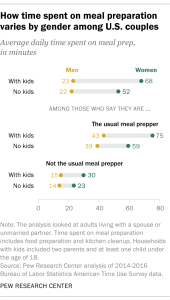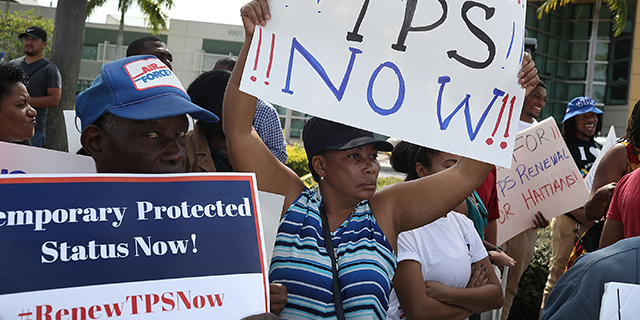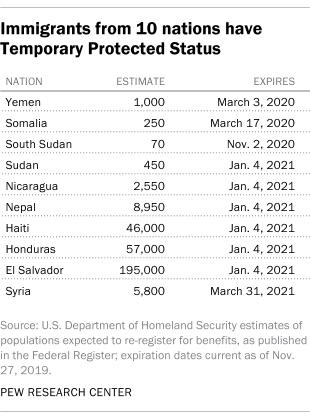

Immigrants who have time-limited permission to live and work in the United States under a program known as Temporary Protected Status (TPS) face an uncertain future amid legal and political debates over their future.

Roughly 317,000 people from 10 countries currently have this protected status after fleeing their home nations because of war, hurricanes, earthquakes or other extraordinary conditions that could make it dangerous for them to live there. The Trump administration has ordered an end to TPS benefits for nearly all immigrants who had them, stating that the program is meant to provide temporary rather than long-term relief. But a series of lawsuits challenging the administration’s decision have blocked those orders from taking effect, giving the vast majority of these immigrants a reprieve until early 2021.
In a Federal Register notice this month, the Department of Homeland Security said it would extend TPS through Jan. 4, 2021, for immigrants from El Salvador, Haiti, Honduras, Nepal, Nicaragua and Sudan. These six countries account for 98% of all current TPS recipients.
TPS protections for these immigrants were to expire at various times in 2019 and early 2020, but the government has extended the expiration date as federal courts consider legal challenges to the administration’s termination of benefits. In the notice, the government said that if it wins the lawsuits, it would give immigrants from El Salvador a year to leave the U.S. and give immigrants from the other five nations 120 days to leave. El Salvador’s immigrants would be given more time to leave in part to recognize that nation’s “continued cooperation building asylum capacity and commitment to stopping illegal migration in the region,” the Department of Homeland Security said.
When it comes to the four remaining countries whose immigrants have TPS – Somalia, South Sudan, Syria and Yemen – the government has extended those designations until 2020 or 2021.
In all, immigrants with Temporary Protected Status represented about 3% of the 10.7 million unauthorized immigrants living in the U.S. in 2016, according to a Pew Research Center analysis of government data. Yet this share was higher for some countries. Immigrants with TPS accounted for about a quarter of unauthorized immigrants from El Salvador (27%) and around 13% of those from Honduras in 2016, for example. (This analysis assumes that immigrants with TPS are in the U.S. without authorization.)
Once the Department of Homeland Security designates a nation’s immigrants as eligible for Temporary Protected Status, immigrants may apply if they entered the U.S. without authorization or entered on a temporary visa that has expired. Applicants may also have a valid temporary visa or another non-immigrant status such as foreign student.
To be granted TPS, applicants must meet filing deadlines, pay a fee and prove they have lived in the U.S. continuously since the events that triggered relief from deportation. They also must meet criminal-record requirements – for example, that they have not been convicted of any felony or two or more misdemeanors while in the U.S., or been engaged in persecuting others or terrorism.
Temporary Protected Status does not make individuals automatically eligible for permanent residence or U.S. citizenship, but some may apply for permanent lawful status. Federal officials are required to announce 60 days before any TPS designation expires whether it will be extended. Without a decision, it automatically extends six months.
Here is more detailed information about the largest origin groups now protected under TPS, based on the most recent Federal Register notices for each country and other sources:
The populations in this post from each country with Temporary Protected Status (TPS) are estimates of the number allowed to stay and work in the U.S. The figures come from Department of Homeland Security (DHS) estimates, published in the Federal Register, and represent the most recent estimate of the number of current beneficiaries who are expected to file for re-registration for TPS. The Federal Register notices cited for these 10 estimates were published between January 2016 and September 2017. These estimates likely overstate current TPS populations because some people have changed their immigration status, left the country or died. The total number from these estimates is 317,070.
The Federal Register notices used as the basis for the numbers in this post include those for El Salvador, Haiti, Honduras, Nepal, Nicaragua, Somalia, South Sudan, Sudan, Syria and Yemen.
DHS changed the nature of the estimates in Federal Register notices published since December 2017 to cite the total number of “current beneficiaries” – a figure that represents the total number of people who have received TPS designation regardless of whether they have changed their immigration status, left the U.S. or died. This total for these 10 countries is 437,024.
DHS also publishes numbers for each country of how many people were ever granted TPS, minus those who have become naturalized U.S. citizens. These numbers also include some people who have changed their immigration status, left the country or died. The total number, obtained by accessing the U.S. Citizenship and Immigration Services “Immigration and Citizenship Data” page and filtering for people with Temporary Protected Status as of November 2018, is 417,341.
EL SALVADOR
[fungus disease]
HAITI
There were about 100,000 unauthorized immigrants from Haiti in the U.S. in 2016 overall, according to the Center’s estimates. U.S. government officials estimate about 46,000 Haitian immigrants had Temporary Protected Status as of 2017, the last time they had to re-register for benefits.
The TPS designation for Haiti was based on an earthquake that killed hundreds of thousands of people in January 2010. Immigrants also are eligible if they entered the U.S. up to a year later – so any Haitian immigrant with protected status has been in the U.S. since at least early 2011.
HONDURAS and NICARAGUA
There are 57,000 Hondurans and roughly 2,550 Nicaraguans with Temporary Protected Status, as of 2016 estimates when they were asked to re-register. (These are the most recent re-registration notices that included estimates of how many people were expected to re-register. See dropdown note for more information.) In 2016, there were an estimated 425,000 unauthorized immigrants from Honduras and around 70,000 from Nicaragua overall.
Immigrants from Honduras and Nicaragua who qualify for TPS must have been living in the U.S. as of Dec. 30, 1998. Immigrants from both countries were designated eligible for TPS based on damage from Hurricane Mitch in 1998. The storm killed more than 5,600 people in Honduras and more than 3,000 in Nicaragua. The government of Honduras had also requested an extension of TPS.
Because of data limitations, Pew Research Center has not estimated the TPS share of unauthorized immigrants from the other six countries. They include Nepal (with 8,950 immigrants with TPS), Somalia (250), South Sudan (70), Sudan (450), Syria (5,800) and Yemen (1,000).
Congress and President George H.W. Bush authorized the TPS program in the 1990 immigration law, granting the White House executive power to designate and extend the status to immigrants in the U.S. based on certain criteria.
Note: This is an update of a post originally published Nov. 8, 2017.
For the most recent information on Temporary Protected Status by country, see the Department of Homeland Security TPS page.


